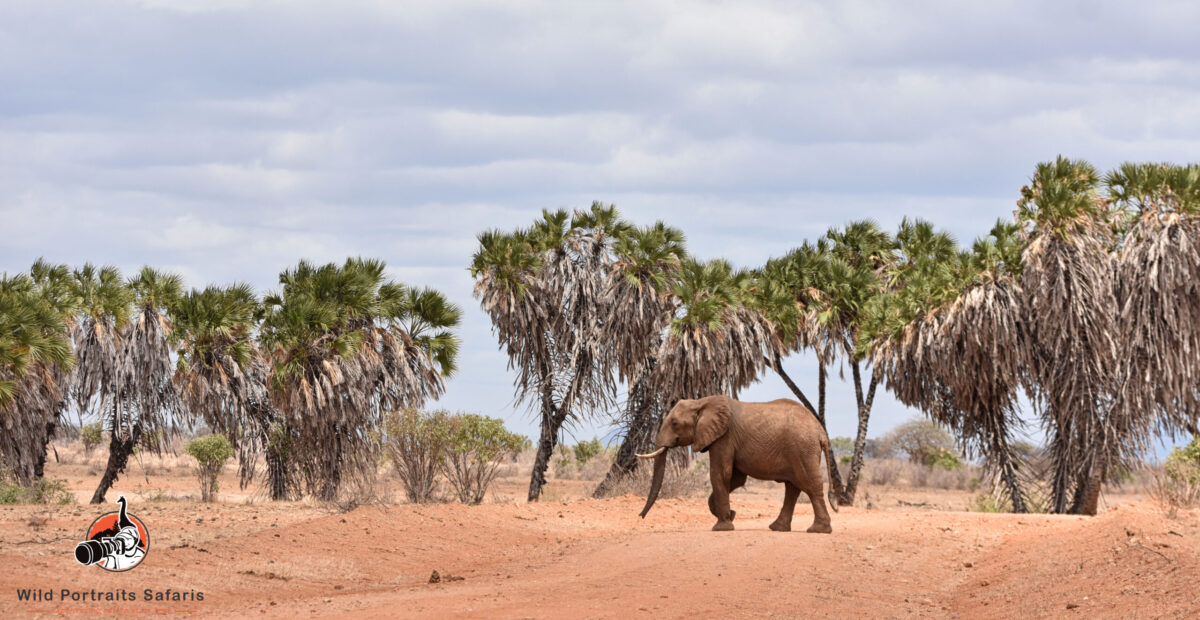Tsavo East National Park
Tsavo East National Park Safari Tours the land of the red Elephants. Tsavo East Kenya’s Biggest Safari Park and Rightly described by Kenya wildlife service as the “theatre of the Wild” Tsavo East is a magical safari destination. Tsavo derived Maasai word Sabuk which means a river. The Maa people called the Tsavo river Engare sabuk meaning a big river. It is one of the oldest and largest parks in Kenya. 13747 square Kilometres hosting the biggest herds of elephants in Kenya, lions’ leopards’ cheetahs kudus the endangered hirola antelope amongst many more species. Previously known as the Taru desert, this same arid area was established as a National Park in 1948.
lion on an early morning game drive Tsavo East
The beautiful and scenic Tsavo East is Kenya’s Biggest Safari Park was in 700AD and earlier an area where Swahili merchants traded with the inhabitants for cats’ skin ivory and slaves. The inhabitants were the Wathe and Orma who were primarily hunters and gatherers. In the Late 19th Early 20th Century, the British colonial government began to put more effort to colonize the interior of Kenya and built a railway through Tsavo East around 1898. Two “man-eating lions” terrorized the construction crews led by Lt. Col Patterson who eventually shot the pair not before they had killed a good number Indians and local workers. It is not exactly known why the lions turned to man as their source of food but According to Bruce Patterson’s in book The Lions of Tsavo: Exploring the Legacy of Africa’s Notorious Man-Eaters, these lions started hunting men for one or more of these four reasons:
- In 1898, an outbreak of cattle plague left the lions with no food. They had to find some other food source, and they turned to humans.
- The lions may have developed an appetite for humans from eating dead men found in the Tsavo River region.
- The Hindus working on the railway had cremations for their dead, which may have initiated scavenging by the lions.
- Severe dental disease meant that the lions migrated to humans as prey that was easier to catch and chew.
Tsavo East or the Taru desert remained the homeland for Orma pastoralists and Watha hunter-gatherers until 1948, when it was gazetted a national park. At that time, the Orma with their livestock were driven off and the the Watha people were forcefully relocated to Voi and Mtito Andei as well as other locations within the nearby Taita Hills.
photography safari at Tsavo East
In the current ecosystem that is Tsavo East National Park, the Athi and Tsavo rivers converge to form the Galana River. Most of the park consists of semi-arid grasslands and savanna. It is considered one of the world’s biodiversity strongholds, and its popularity is mostly due to the vast amounts of diverse wildlife that can be seen. The park is also home to a great variety of bird life such as the golden breasted starling, vultures, bateleur and a variety of other eagles. Tsavo East National Park is generally flat, with dry plains across which the Galana River flows. Other features include the the longest lava flow in the world, the 300km Yatta Plateau and picturesque Lugard Falls, named after Frederick Lugard, is a series of white-water rapids on the Galana River. Next to Ashnil camp is Aruba Dam which was built in 1952 across the Voi River and attracts many animals and water birds. The 1.6 km inselberg of stratified rock known as the Mudanda rock acts as a water catchment that supplies a natural dam below. It offers an excellent vantage point for the hundreds of elephants and other wildlife that come to drink during the dry season.
Why visit Tsavo East National Park?
Simply for its scenic landscapes and abundance of wildlife, and less congested giving you the rustic safari feel. The iron rich red soils that are a sharp contrast to the grey savanna and commiphora bushes make it an enticing wildlife photography destination. The elephants wallow and dust bath in the soil giving them a red “icing” over their normal grey skin. Photography along the palm tree lined Galana river makes it a set up like no other for unique captures. It is an excellent elephant safari destination where we still have big herds and as well as huge tuskers still roaming freely in the wild. The cat population density is also good with high chances of seeing the elusive leopard, cheetah and lions. On a lucky day you will also encounter the highly endangered African wild dogs. The hirola or the hunters hartebeest which is considered to be the most critically endangered antelope is found in Tsavo West. Infact there are two populations, a natural population on the Kenyan–Somali border and a translocated population in Tsavo East National Park, Kenya. The Tsavo population is becoming increasingly important for the survival of the hirola.
The elephants of Tsavo East
Where to Stay at Tsavo East
Whether on a tight budget or prefer luxury Tsavo East Accomodation range caters for all
Below are some of the places you can stay as you get closer to mother nature:
Galdessa Camp–exclusive and luxurious camp located next to Galana river
Ashnil Aruba – located right next to Aruba dam
Ngutuni Lodge
Best Time to visit Tsavo East
The Best time to visit Tsavo East National Park is from June to October and January to February, when conditions in this amazing park are favorable for rewarding game drives.

